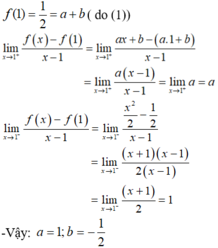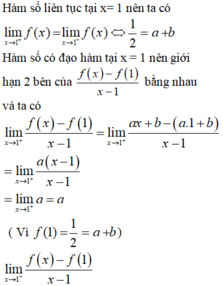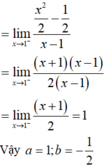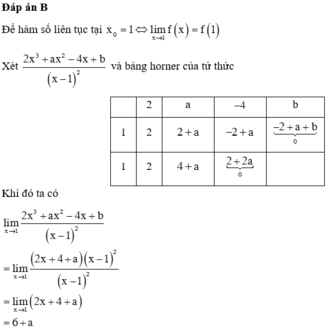Hãy nhập câu hỏi của bạn vào đây, nếu là tài khoản VIP, bạn sẽ được ưu tiên trả lời.

1.
\(f'\left(x\right)=3x^2-6mx+3\left(2m-1\right)\)
\(f'\left(x\right)-6x=3x^2-3.2\left(m+1\right)x+3\left(2m-1\right)>0\)
\(\Leftrightarrow x^2-2\left(m+1\right)x+2m-1>0\)
\(\Leftrightarrow x^2-2x-1>2m\left(x-1\right)\)
Do \(x>2\Rightarrow x-1>0\) nên BPT tương đương:
\(\dfrac{x^2-2x-1}{x-1}>2m\Leftrightarrow\dfrac{\left(x-1\right)^2-2}{x-1}>2m\)
Đặt \(t=x-1>1\Rightarrow\dfrac{t^2-2}{t}>2m\Leftrightarrow f\left(t\right)=t-\dfrac{2}{t}>2m\)
Xét hàm \(f\left(t\right)\) với \(t>1\) : \(f'\left(t\right)=1+\dfrac{2}{t^2}>0\) ; \(\forall t\Rightarrow f\left(t\right)\) đồng biến
\(\Rightarrow f\left(t\right)>f\left(1\right)=-1\Rightarrow\) BPT đúng với mọi \(t>1\) khi \(2m< -1\Rightarrow m< -\dfrac{1}{2}\)
2.
Thay \(x=0\) vào giả thiết:
\(f^3\left(2\right)-2f^2\left(2\right)=0\Leftrightarrow f^2\left(2\right)\left[f\left(2\right)-2\right]=0\Rightarrow\left[{}\begin{matrix}f\left(2\right)=0\\f\left(2\right)=2\end{matrix}\right.\)
Đạo hàm 2 vế giả thiết:
\(-3f^2\left(2-x\right).f'\left(2-x\right)-12f\left(2+3x\right).f'\left(2+3x\right)+2x.g\left(x\right)+x^2.g'\left(x\right)+36=0\) (1)
Thế \(x=0\) vào (1) ta được:
\(-3f^2\left(2\right).f'\left(2\right)-12f\left(2\right).f'\left(2\right)+36=0\)
\(\Leftrightarrow f^2\left(2\right).f'\left(2\right)+4f\left(2\right).f'\left(2\right)-12=0\) (2)
Với \(f\left(2\right)=0\) thế vào (2) \(\Rightarrow-12=0\) ko thỏa mãn (loại)
\(\Rightarrow f\left(2\right)=2\)
Thế vào (2):
\(4f'\left(2\right)+8f'\left(2\right)-12=0\Leftrightarrow f'\left(2\right)=1\)
\(\Rightarrow A=3.2+4.1\)

\(\lim\limits_{x\rightarrow1^-}y=\lim\limits_{x\rightarrow1^-}\left(2x+a\right)=a+2\)
\(\lim\limits_{x\rightarrow1^+}y=\lim\limits_{x\rightarrow1^+}\left(x^2+2ax+a+b\right)=3a+b+1\)
Hàm liên tục tại \(x=1\Leftrightarrow a+2=3a+b+1\Leftrightarrow2a+b=1\)
\(y'\left(1^+\right)=2\)
\(y'\left(1^-\right)=\left(2x+2a\right)_{x=1^-}=2a+2\)
\(\Rightarrow\left\{{}\begin{matrix}2a+b=1\\2a+2=2\end{matrix}\right.\) \(\Rightarrow\left\{{}\begin{matrix}a=0\\b=1\end{matrix}\right.\)

- Ta có:

- Hàm số đã cho có đạo hàm tại x = 1 nên hàm số liên tục tại x = 1.

- Hàm số có đạo hàm tại x = 1 nên giới hạn 2 bên của  bằng nhau, ta có:
bằng nhau, ta có:

Chọn A.




Đáp án D
Ta có: f(2) = 4
lim x → 2 − f ( x ) = lim x → 2 − x 2 = 4
lim x → 2 + f ( x ) = lim x → 2 + − x 2 2 + b x − 6 = 2 b − 8
Vì hàm số có đạo hàm tại x= 2 nên hàm số liên tục tại x = 2
⇔ lim x → 2 − f ( x ) = lim x → 2 + f ( x ) ⇔ 4 = 2 b − 8 ⇔ b = 6